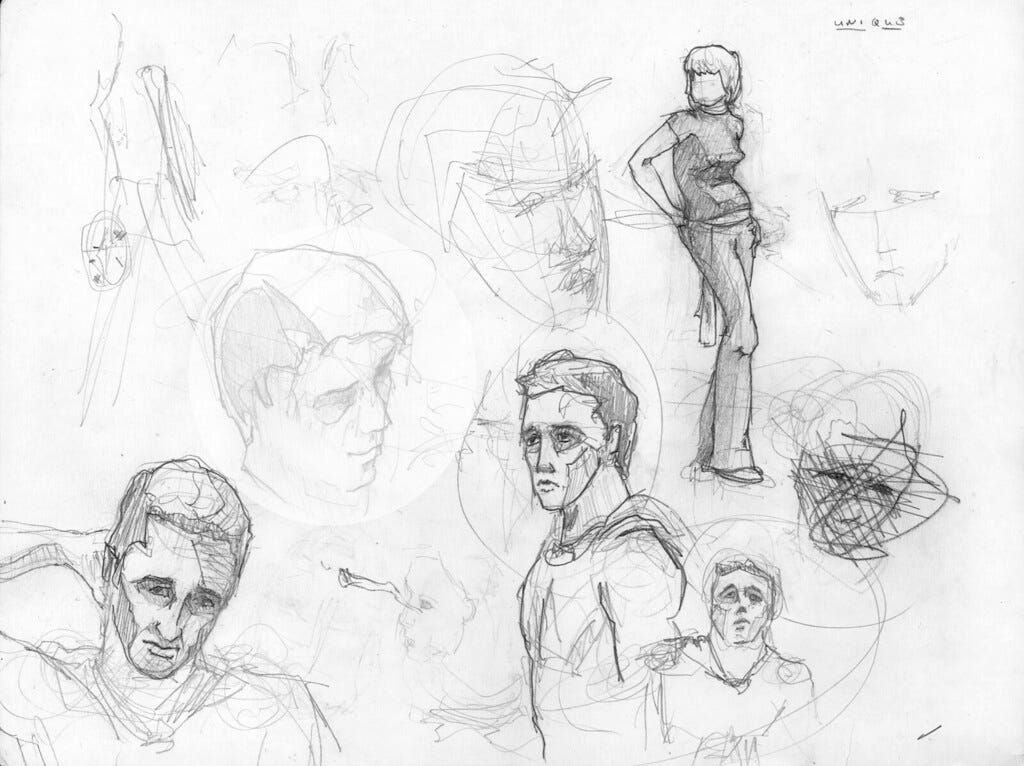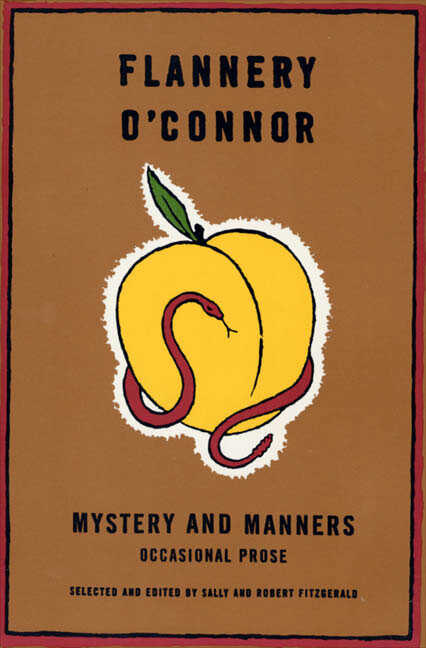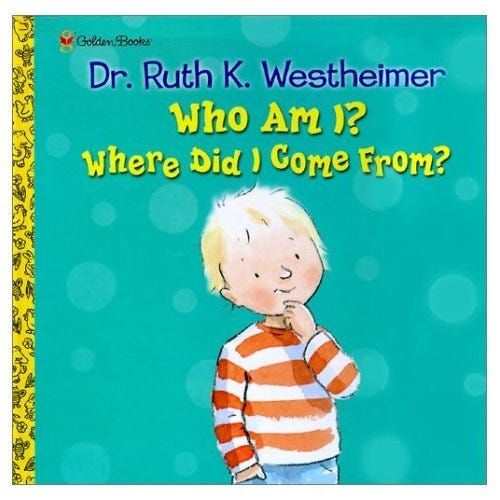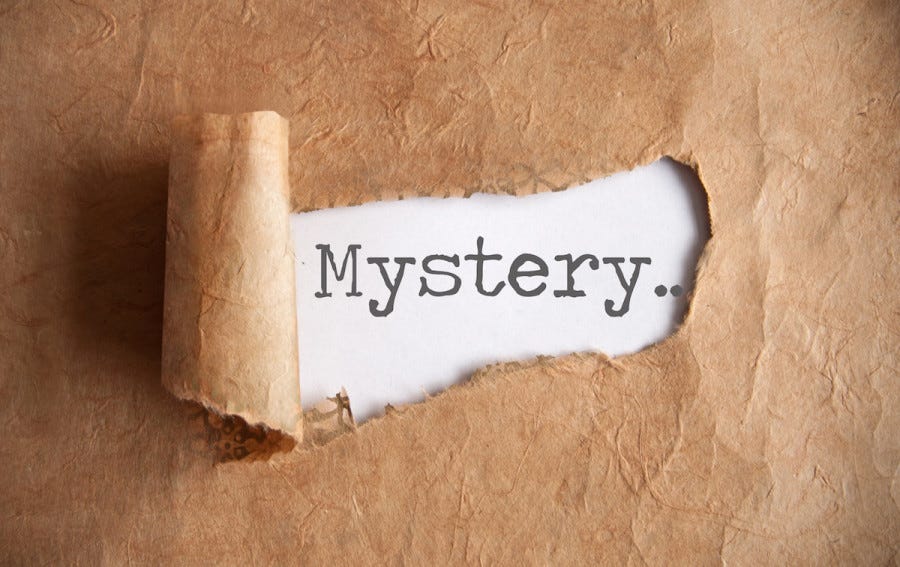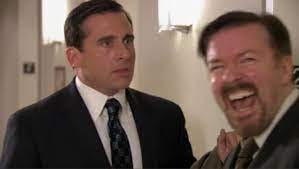Sketchy Characters (#2)
Today’s Writing Music: “It’s Time to Come Home” by The Rentals
Today’s Reading: Refuse to Be Done: How to Write and Rewrite a Novel in Three Drafts by Matt Bell
In last week’s post I talked about ways of describing characters—how they’re introduced to readers in the first place. I think of that physical description, perhaps in combination with their “single brushstroke,” as the outermost layer in a character. Together they tell a reader how they are to be seen, and how they are typically seen by others in the world.
But what’s underneath of the hood? How does a character see themselves, and how is that different from how other see them?
In the previous post, I also mentioned how, in the novel Straight Man by Richard Russo, the character Professor Hank Devereaux gives an exercise in a writing class. He has his students think about their characters and try to fill in the blanks on this direct statement:
““I know you, _________________. You’re (not) the kind of man who_________________”
This is a good way to nail down that single brushstroke, and hopefully by now you’ve gotten to try it out a little.
If you remember, I got a bit ahead of myself, into Layer #2 already, by writing this:
(Russo does a very touching thing with this idea later in the novel. The professor has an epiphany that in life we all rely on “spouses and children and parents and colleagues and friends” to define ourselves in this same way “…because someone has to know us better than we know ourselves. We need them to tell us. We need them to say, ‘I know you, Al. You are not the kind of man who.’”)
What Russo lays out here is, I think, an essential human truth: that we don’t always (often?) see ourselves the same way that others see us. And the gap between the two is everything in fiction. It gives a character room to grow, to gain self-knowledge, to become surprised, and even to go out in search of something.
In an essay on fiction, “Mystery & Manners,” author Flannery O’Connor defines two qualities that “make fiction”: 1) the sense of mystery and 2) the sense of manners. She spends much of the piece discussing the latter, and the importance of the world surrounding your character—speaking to what context they exist within.
You can’t cut characters off from their society and say much about them as individuals. You can’t say anything meaningful about the mystery of a personality unless you put that personality into a believable and significant social context.
Her main point in this section is that a character from, say, Pittsburgh, shouldn’t speak/act/think the same way as a character from Des Moines or Toronto or Portland. If you tried to take your story and just substitute new place names—magically teleporting the whole thing to a different place than before—your story should quickly fall apart. That is, if you’d taken the care to consider all the characters’ environmental contexts when creating them in the first place. If you could transport it effortlessly, O’Connor argues, that’s a sign of a bigger, deeper problem.
Sometimes I struggle with O’Connor’s dictum: it seems to favor geography over other factors like class, race, educational background. The same, I’d argue would hold true for these: if I take a white character and just change their physical description to make them Black… or Chinese-American, that’s just not going to work. These factors go much deeper than just an external description, in other words.
And even when it comes to geography, I strain at this sometimes. I grew up in suburban New Jersey, but haven’t lived there for twenty years. I spent fourteen years in Manahattan and Brooklyn, and have considered myself a New Yorker at times, knowing full-well that to anyone born there, I wouldn’t rate at all. Now I live in Westchester with my wife and children, where I also don’t really feel like I belong, sometimes.
I’m just not quite trying to do the same thing as O’Connor, who lived her whole life deeply engaging in her work with the American South (and particularly in rural and urban Georgia) mainly around other people with roots there going back generations. The manners of that specific place will shape the characters she’s writing about because that’s not just where they’re from, but where they have always lived and always will live.
I think about her manners idea sometimes as being a little like turning grapes into wine. At the heart of it, O’Connor wants us, as readers, to be able to tell on the other end where her characters are from, like wine connoisseurs who, with a few sips can identify the terroir the wine’s grapes grew in, and know how the sunshine/rainfall/soil content have affected the flavor. Once, I watched a man skilled at this identify even between different vintages, because he knew that the 1987 had been a rainier year than the 1988, let’s say. Or that there’d been fires nearby in 1992, but not in 1993.
In the wine-tasting metaphor my characters and I would be more like a “blend” then, combining grapes and flavors from many places into something quite complicated in the end. This feels like a much-needed modern update to the M&M theory. (And my context, ultimately, isn’t even that complicated: it’s all within a very narrow band of class and race and religion and so on. What if you, say, grew up in a heavily Taiwanese neighborhood, but you yourself are Afro-Caribbean, who went to public schools in Montreal but then later attended Oxford, and then for ten years you lived in Prague, and now are married to someone from Nairobi, and own a home in Sarasota, Florida?)
In any event, that’s manners. What about the “mystery” part?
O’Connor refers to the “mystery of a personality” as being the main driver of character, and therefore plot. Psychologists say that our “personality” is part of who we are as individuals—perhaps even what makes us an individual. Unique within the context we’ve been discussing.
Is my character organized? Reactionary? Depressive? Optimistic? Introverted? Extroverted? More run by their “id” or “ego”? What do they dream about? What do they want? Where do they see themselves in five years? What’s their relationship to their gender? Their race? Are they very interested in sex? Or not so much? How are they flawed? (And according to whom?) What are they hypocritical about? Do they believe in true love? Are they close to their family? What media do they consume? Favorite film? Favorite food? Favorite book? Do they play chess? If they do, then how do they play? What are their ethics, religious beliefs, relationship to memory, etc., etc., etc.
There is, thankfully, no end to these types of questions when it comes to a character’s personality, and this is why there is no limit to who they can be, and why such a thing as “individuality” exists (debatable, some might say—perhaps a vestige of capitalist CIA influence in my training as a writer, but hey, that’s my context now). You can (and probably should) read thoughts on personality by all manner of thinkers, from Spinoza to Freud to BF Skinner to Jung and on and on and on. They’ll give you loads of ideas about ways to think about yourself, and your characters—but the thing I’d like you to see right now, for this post, is just that there are probably millions of individual inputs, and ways to think about “personality” and that’s what makes it such a “mystery” in O’Connor’s words.
It’s also what makes us all so interested in each other. As O’Connor says, it is one of the things that “makes” fiction—because it is one of the things that makes us human, and drives our interactions towards others, and therefore—drama.
Can we understand the personality of the other? Can the other understand ours? Can we even understand our own?
These are big, complicated questions and I’m going to step back here, because it gets overwhelming, very quickly. We’re here to talk about writing, and how a writer creates a second layer to their character, below the exterior. Now that we’ve discussed both context & personality (manners & mystery) I think it will be a lot easier to demonstrate.
Think about Hank Deveraux again. Russo tells us that it is the people around him in his life who understand what type of man he is and isn’t. Who he really is.
How do we see ourselves differently from how others see us? Which is more accurate?
This “ironic gap”, as I think of it, is crucial when it comes to this second layer of character. Layer #2 is where we see a kind of conflict emerging, a relationship between a self and its society.
Don Quixote sees himself as a brave knight, slaying giants and rescuing damsels in distress. But Cervantes also lets us see that, in reality, he’s a confused, old man who is tilting at windmills (literally). Put into context, Quixote changes completely. For balance, we also get the loyal sidekick Sancho Panza, who shows us that while DQ clearly isn’t quite the hero he thinks he is, he also isn’t always the buffoon everyone else sees.
There is more than one truth, and we read on to see how they can coexist, or if they will, at some point collapse into something new.
We can play this same game with loads of interesting characters in literature: Jay Gatsby, Captain Ahab, Elizabeth Bennet, Holden Caulfield, Saleem Sinai, Esteban Trueba, Pecola Breedlove… there’s some key difference between how the author/we see them and how they see themselves. That tension then, drives the plots of these novels, as we wait for these two truths to collapse into one.
To see two ways of using this “ironic gap” to create character, let’s turn to a beloved TV character for a moment.
Michael Scott, head of the Scranton branch of the Dunder Mifflin paper company on the TV show The Office, is a great example of a character whose personality has a public/private disconnect.
Comically, he believes himself to be the “World’s Best Boss” (as shown on his favorite coffee mug). He also believes himself to be a great comedian, whose employees love his jokes and enjoy working for him and think of him lovingly as almost a father figure—he often talks about the others in the office as being his “family”.
But, in the show, in context, we see that he is exactly none of these things. He is not a good boss—he acts inappropriately, he’s lazy, he’s disorganized, he’s offensive, he’s basically a six-year-old in a poor-fitting suit. His employees never laugh at his jokes, but always at how terrible they are, and how bad he is at telling them—Michael just can’t tell the difference. They don’t enjoy working for him, and they don’t think of him as a family member at all, but usually just as a constant annoyance that they pray to avoid outside of work hours.
Michael Scott is a great example of an ironic character. His perception of himself is almost wholly at odds with his perception by everyone else. This creates constant tension and plot and drama in each episode of the show.
And yet, part of the reason that the TV show has become beloved, and why Michael Scott is—for all his flaws—also beloved by audiences, is that despite all of his awkward and painful confusion about himself, there is something admirable at Michael’s core. He acts this way because he loves his employees. We see him fight desperately to keep their branch from closing, and in the end his bad behavior is usually forgivable because it comes from a place of loving and wanting to be loved.
Now, a contrast. If you’ve seen the original UK version of The Office, starring Ricky Gervais as “David Brent” in the boss’s role, you’ll see that there’s another way this kind of irony can cut. Brent is quite similar to Scott—and in the first season they are much closer to one another—but the differences grow over time. Brent’s egotism and narcissism often lead him to bully his employees, rather than love them. His heart’s really never in the right place. He’s spiteful, frustrated by their inability to appreciate what he believes is his comedic genius, and baffled as to why they don’t really like him. It’s the same ironic gap here, just a different set of motives underneath.
Thinking back to Flannery for a moment—the US Office initially tried to do exactly what she forbade: take a character out of his context and put him down in a new one. As she warned, it doesn’t work. In the early episodes of The Office (US), Michael’s humor is much too cynical and cruel for the context of a US workplace, whereas, in the context of the UK’s “Wernham Hogg Paper Merchants” David Brent seems totally plausible. In several interviews, the showrunners Stephen Merchant (UK) and Greg Daniels (US) have explained as much—they realized that a mainstream US audience simply wouldn’t accept Michael acting as David does, without facing consequences. In the UK, that seems not to be a concern, sadly.
Anyway, even as Michael began to become distinct from David, their behaviors weren’t always so different. But even in those early episodes, something deeper does set them apart. Steve Carell often delivered the same lines, sometimes, just a bit differently, than Gervais had. This ripples out into what we might call their personality on the surface, by small alterations to their motivations. Scott wants to be loved, Brent wants to be respected. Eventually we’re won over by the former, but never in the latter case.
James Wood, in How Fiction Works, discusses a modern (he says a “Dostoyevskian”) character as having a series of at least three layers. I’ll talk about the third layer next time, but for now let’s look at his concept of #1 and #2:
On the top layer is the announced motive: Raskolnikov, say, proposes several justifications for his murder of the old woman (in Crime & Punishment). The second layer involves unconscious motivation, those strange inversions wherein love turns to hate and guilt expresses itself as poisonous, sickly love.
Raskolnikov, in Crime & Punishment believes himself to be some kind of ubermensch, a super-man whose superiority he will prove by murdering a puny regular human without feeling remorse or paying any consequences. But, in fact, he’s not, and his motives weren’t nearly so Nietzschean as he tricked himself into thinking, as Wood points out above.
There’s something similar going on here. Announced motive is part of the public side of the character. Why does Michael Scott misbehave all the time in The Office? To be funny, to make sure everyone knows he’s the “cool boss” who they all enjoy working for. He says as much all the time, to them, and to us directly when he speaks to the camera.
But what’s the unannounced motive? He wants to be loved. Maybe it’s even deeper than that, he’s desperately afraid of being unloved—which is why it can be so cringy, or even a bit repulsive sometimes. Eventually this all needs to be reconciled, and as the show goes on through its seasons, Michael does, slowly, learn to behave better. He falls in love, for real, with a woman in HR (the only person who finds him truly funny) who tries to help him see that his workers are not his family. In the end they come to somewhere in the middle, with him realizing what real love actually is and her realizing that his love for his employees is big part of why he really is a good boss.
Now, that’s a comedy, and one with a suitably happy end. In literature it may not always be so clean. (Raskolnikov, for instance, eventually unravels and confesses to the murder he’s committed, and only in his punishment and exile does he have a kind of religious rebirth.)
The key thing here, for us, is to figure out the difference between who our character is perceived to be by others, and how they perceive themselves. What do they say their own motives are, and what do others think their motives are? Who then, is closer, to the true unconscious motivations? What’s going to happen to bring those two sides together?
Figure that out, and you’ve got a character. More than that, you’ve got a story.
More next week, diving into the third layer of character… until then, have fun!
Writing Towards the Fun #22:
Write a short scene where your character interacts with someone else, or many others, in an attempt to get something they want. What are their motives? Public and private? How aware are they of why they’re really doing what they’re doing?
Now write the same scene but from the point of view of the other person, or one of the other people. What do they think of your original character and how is it different? And of course now you have a new perspective that comes with its own public/private divide… so you can explore it in reverse as well.
Did something dramatic begin to emerge? Almost certainly… keep at it, and have fun!




